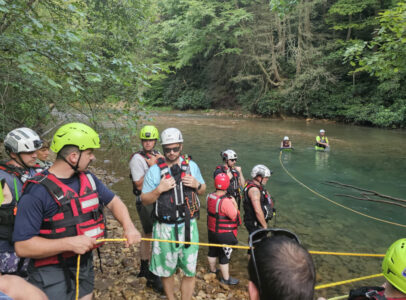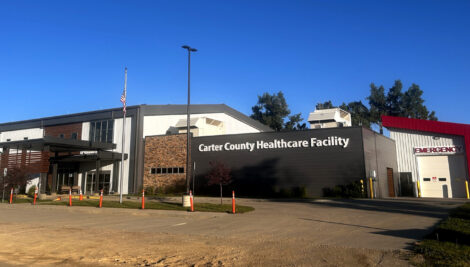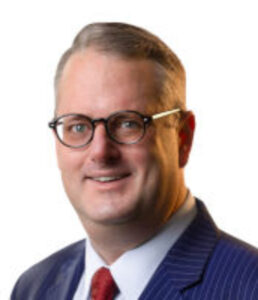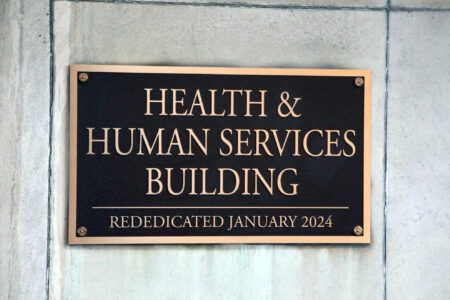Experts: rural emergency rooms are increasingly run without docs
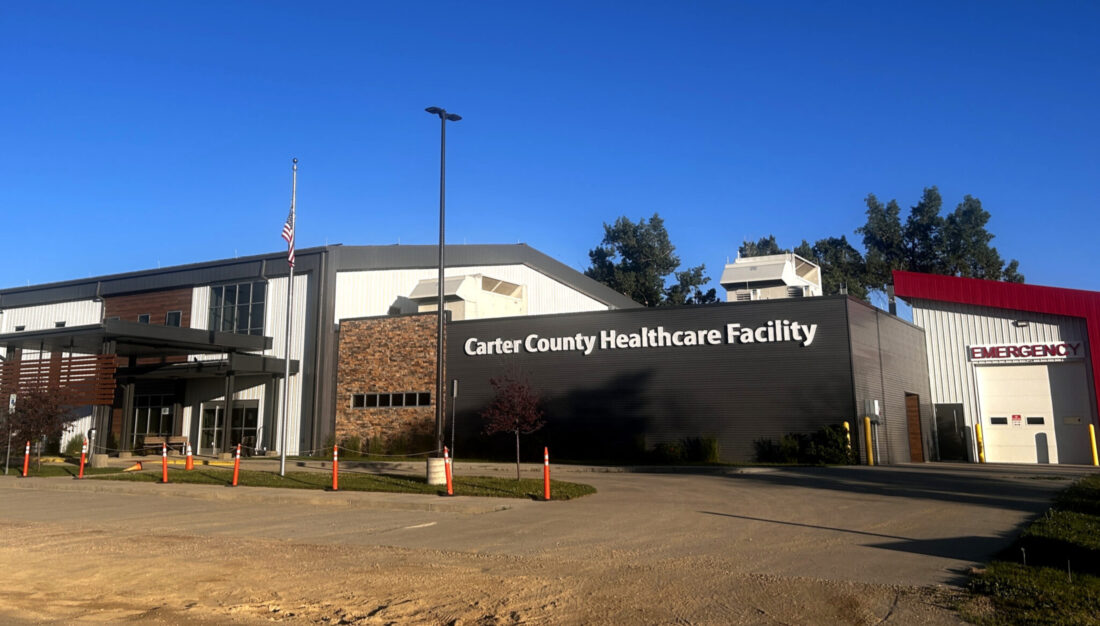
Arielle Zionts/KFF Health News The hospital in Ekalaka, a small town in sprawling, rural southeastern Montana, sits at the intersection of two dirt roads.
There was no doctor on-site when a patient arrived in early June at the emergency room in the small hospital at the intersection of two dirt roads in this town of 400 residents.
There never is.
Dahl Memorial’s three-bed emergency department — a two-hour drive from the closest hospital with more advanced services — instead depends on physician assistants and nurse practitioners.
Physician assistant Carla Dowdy realized the patient needed treatment beyond what the ER could provide, even if it had had a doctor. So, she made a call for a medical plane to fly the patient to treatment at Montana’s most advanced hospital. Dowdy also called out medications and doses needed to stabilize the patient as a paramedic and nurses administered the drugs, inserted IV lines, and measured vital signs.
Emergency medicine researchers and providers believe ERs, especially in rural areas, increasingly operate with few or no physicians amid a nationwide shortage of doctors.
A recent study found that in 2022, at least 7.4% of emergency departments across the U.S. did not have an attending physician on-site 24/7. Like Dahl Memorial, more than 90% were in low-volume or critical access hospitals — a federal designation for small, rural hospitals.
The results come from the 82% of hospitals that responded to a survey sent to all emergency departments in the country, except those operated by the federal government. The study is the first of its kind so there isn’t proof that such staffing arrangements are increasing, said Carlos Camargo, the lead author and a professor of emergency medicine at Harvard Medical School. But Camargo and other experts suspect ERs running without doctors present are becoming more common.
Placing ERs in the hands of nondoctors isn’t without controversy. Some doctors and their professional associations say physicians’ extensive training leads to better care, and that some hospitals are just trying to save money by not employing them.
The American Medical Association, open to all medical students and physicians, and the American College of Emergency Physicians both support state and federal laws or regulations that would require ERs to staff a doctor around the clock. Indiana, Virginia, and South Carolina recently passed such legislation.
Rural ERs may see fewer patients, but they still treat serious cases, said Alison Haddock, president of ACEP.
“It’s important that folks in those areas have equal access to high-quality emergency care to the greatest extent possible,” Haddock said.
Other health care providers and organizations say advanced-practice providers with the right experience and support are capable of overseeing ERs. And they say mandating that a physician be on-site could drive some rural hospitals to close because they can’t afford or recruit enough — or any — doctors.
“In an environment, especially a rural environment, if you have an experienced PA who knows what they know, and knows the boundaries of their knowledge and when to involve consultants, it works well,” said Paul Amiott, a board member of the Society of Emergency Medicine PAs.
“I’m not practicing independently” despite working 12-hour night shifts without physicians on-site at critical access hospitals in three states, he said.
Amiott said he calls specialists for consultation often and about once a month asks the physician covering the day shift at his hospital to come help him with more challenging cases such as emergency childbirth and complicated trauma. Amiott said this isn’t unique to PAs — ER doctors seek similar consultations and backup.
The proportion of ERs without an attending physician always on-site varies wildly by state. The 2022 survey found that 15 states — including substantially rural ones, such as New Mexico, Nevada, and West Virginia — had no such emergency departments.
But in the Dakotas, more than half of emergency departments were running without 24/7 attending physician staffing. In Montana it was 46%, the third-highest rate.
None of those three states have a program to train physicians as ER specialists. Neither does Wyoming or Idaho.
But Sanford Health, which bills itself as “the largest rural health system in the United States,” is launching an emergency medicine residency in the region. The Sioux Falls, South Dakota-based program is intended to boost the ranks of rural emergency doctors in those states, the residency director said in a news release.
Leon Adelman is an emergency medicine physician in Gillette, Wyoming, which, at around 33,800 residents, is the largest city in the state’s northeast. Working in such a rural area has given him nuanced views on whether states should require 24/7 on-site physician coverage in ERs.
Adelman said he supports such laws only where it’s feasible, like in Virginia. He said the state’s emergency physicians’ organization pushed for the law only after doing research that made it confident that the requirement wouldn’t shutter any rural hospitals.
Camargo said some doctors say that if lawmakers are going to require 24/7 on-site physician coverage in ERs, they need to pay to help hospitals implement it.
Adelman said when instituting staffing requirements isn’t possible, states should create other regulations. For example, he said, lawmakers should make sure hospitals not hiring physicians aren’t refraining just to save money.
He pointed to Vermont, where a report recommended that several of the state’s hospitals cut physicians from their ERs. The report was part of a mandated process to improve the state’s troubled health care system.
Adelman said states should also require PAs and NPs without on-site physician supervision to have extensive emergency experience and the ability to consult with remote physicians.
Some doctors have pointed to a case in which a 19-year-old woman died after being misdiagnosed by an NP who was certified in family medicine, not emergency care, and working alone at an Oklahoma ER. Few NPs have emergency certification, an analysis found.
The Society of Emergency Medicine PAs outlines training and experience PAs should have before practicing in rural areas or without on-site doctors.
Haddock said emergency physicians have seen cases of hospitals hiring inexperienced advanced-practice providers. She said ACEP is asking the federal government to require critical access and rural emergency hospitals to have physicians on-site or on call day and night.
Haddock said ACEP wouldn’t want such a requirement to close any hospital and noted that the organization has various efforts to keep rural hospitals staffed and funded.
Dahl Memorial Hospital has strict hiring requirements and robust oversight, said Dowdy, who previously worked for 14 years in high-volume, urban emergency rooms.
She said ER staffers can call physicians when they have questions and that a doctor who lives on the other side of Montana reviews all their patient treatment notes. The ER is working on getting virtual reality glasses that will let remote physicians help by seeing what the providers in Ekalaka see, Dowdy said.
She said patient numbers in the Ekalaka ER vary but average one or two a day, which isn’t enough for staff to maintain their knowledge and skills. To supplement those real-life cases, providers visit simulation labs, do monthly mock scenarios, and review advanced skills, such as using an ultrasound to help guide breathing tubes into patient airways.
Dowdy said Dahl Memorial hasn’t had a physician in at least 30 years, but CEO Darrell Messersmith said he would hire one if a doctor lived in the area. Messersmith said there’s a benefit to having advanced-practice providers with connections to the region and who stay at the hospital for several years. Other rural hospitals, he noted, may have physicians either as permanent staff who leave after a few years or contract workers who fly in for a few weeks at a time.
People eating at Ekalaka’s sole breakfast spot and attending appointments at the hospital’s clinic all told KFF Health News that they’ve been happy with the care they have received from Dowdy and her co-workers.
Ben Bruski had to visit the ER after a cow on his family ranch kicked a gate, smashing it against his hand. And he knows other people who’ve been treated for more serious problems.
“We’ve got to have this facility here because this facility saves a lot of lives,” Bruski said.
——
KFF Health News is a national newsroom that produces in-depth journalism about health issues and is one of the core operating programs at KFF — the independent source for health policy research, polling, and journalism.
——
Pennsylvania Capital-Star is part of States Newsroom, a network of news bureaus supported by grants and a coalition of donors as a 501c(3) public charity. Pennsylvania Capital-Star maintains editorial independence. Contact Editor Tim Lambert for questions: info@penncapital-star.com. Follow Pennsylvania Capital-Star on Facebook and Twitter.

